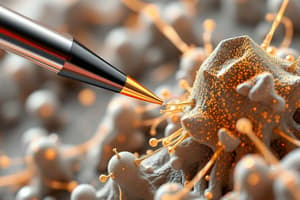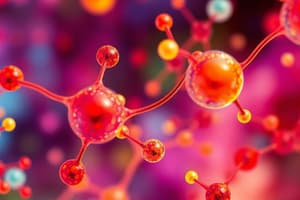Podcast
Questions and Answers
What is the principle behind AFM?
What is the principle behind AFM?
- Scanning electron microscopy
- Piezoelectric scanning
- Cantilever principle (correct)
- Optical microscopy
What is the typical diameter of the sharp tip used in AFM?
What is the typical diameter of the sharp tip used in AFM?
- 1-5 nm (correct)
- 60-70 nm
- 20-30 nm
- 40-50 nm
How is a three-dimensional topographical map generated in AFM?
How is a three-dimensional topographical map generated in AFM?
- By utilizing radiation-based microscopy techniques
- By measuring the force exerted on the tip
- By plotting local sample height as a function of horizontal tip location (correct)
- By scanning the cantilever over the surface
What differentiates resolution in AFM imaging from radiation-based microscopy techniques?
What differentiates resolution in AFM imaging from radiation-based microscopy techniques?
How does AFM differ in terms of sample movement compared to other microscopy techniques?
How does AFM differ in terms of sample movement compared to other microscopy techniques?
What is the most common method used to track deflection in scanning probe microscopes?
What is the most common method used to track deflection in scanning probe microscopes?
How does coating the cantilever's back with gold or another metal improve its ability to reflect the laser beam?
How does coating the cantilever's back with gold or another metal improve its ability to reflect the laser beam?
What is the purpose of the scanning stage in an AFM setup?
What is the purpose of the scanning stage in an AFM setup?
What is the composition of the scanning probe typically used in AFM?
What is the composition of the scanning probe typically used in AFM?
Which detection technique is NOT mentioned as part of the detection system in AFM?
Which detection technique is NOT mentioned as part of the detection system in AFM?
Study Notes
Principle of AFM
- Atomic Force Microscopy (AFM) operates on the principle of measuring forces between a sharp probe and a sample surface at the nanoscale.
- It utilizes a cantilever with a sharp tip that reacts to surface forces, allowing for high-resolution topographical imaging.
Tip Characteristics
- The sharp tip used in AFM typically has a diameter in the range of a few nanometers.
Generation of Topographical Maps
- A three-dimensional topographical map in AFM is generated by scanning the probe across the sample surface while measuring the cantilever's deflection.
- The data collected from deflections are converted into a height information, creating detailed surface maps.
Resolution Comparison
- AFM achieves resolution at the atomic level, providing finer detail than radiation-based microscopy techniques which are limited by diffraction.
Sample Movement
- AFM may utilize either sample movement or probe movement for scanning, differing from techniques where samples are often fixed or imaged through lens adjustments.
Deflection Tracking
- The most common method to track deflection in scanning probe microscopes is through optical beam deflection, where a laser beam reflects off the cantilever onto a photodetector.
Cantilever Coating Benefits
- Coating the cantilever's back with gold or another metal enhances its reflective properties, improving the accuracy of laser deflection measurements.
Scanning Stage Purpose
- The scanning stage in an AFM setup serves to precisely control the movement of the sample relative to the probe, ensuring accurate measurements.
Composition of Scanning Probe
- The scanning probe typically consists of a cantilever with a sharp tip made from materials like silicon or silicon nitride.
Detection Techniques
- Techniques not mentioned in the AFM detection system include methods such as electron beam detectors or other imaging methods that do not leverage probe-based interaction.
Studying That Suits You
Use AI to generate personalized quizzes and flashcards to suit your learning preferences.
Description
Learn about the principles of Atomic Force Microscope (AFM) which is based on the cantilever principle and uses a sharp tip to scan surfaces with feedback mechanisms. Understand how the force exerted by the tip on the sample is measured by following the cantilever’s deflection.




